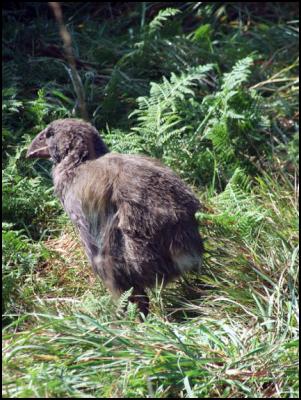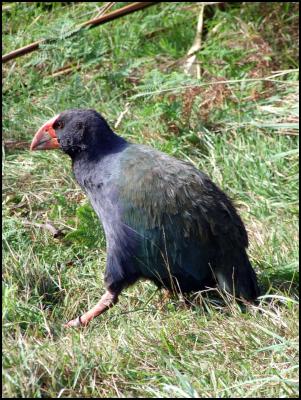Takahe leave island for mountain homeland
31 May 2007
Takahe leave island for mountain
homeland

Three takahe are today
being taken from Tiritiri Matangi destined for the Murchison
Mountains in Fiordland, in a move aimed at increasing the
takahe population as a whole.
It’s the first time that takahe have been transferred from an island sanctuary, where they were sent to help conserve the species, back to the area where the remnant population lives.
DOC island ranger Jennifer Haslam said that the three island-bred birds (named Hauraki, Tiri and Tango), which are offspring of several birds brought to the island in the early 1990s, were being removed to reduce the chances of inbreeding within the small population there.

“By taking these birds off the island we’re freeing up territories for new birds to be added to the island gene pool.”
“A more genetically diverse population on Tiritiri Matangi will be more productive, so that more birds will be available to stock the population in Fiordland.”
The regular cycling of takehe between islands and the mainland to manage the genetic diversity of island populations is seen as crucial to the success of the takahe recovery programme, said Ms Haslam.
The three takahe – two juveniles and one adult female – will spend the winter at DOC’s takahe unit at Burwood Bush near Te Anau. Once the birds have shown that they can adapt to living and feeding in a tussock grassland environment, including getting used to snow, they will be released into the Murchison Mountains.
Since takahe were first introduced to Tiritiri Matangi in 1991, the birds have successfully bred and now number 14. The island sanctuary is one of four – including Maud (in the Marlborough Sounds), Mana and Kapiti islands – used to breed small additional populations of takahe. Together they have added about 60 birds to the overall population.
Tiritiri Matangi, managed in partnership by the Supporters of Tiritiri Matangi and DOC, is the only place north of Auckland you can see takahe in the wild.
The flightless takahe, the largest living member of the rail family, was rediscovered in the Murchison Mountains in 1948. DOC’s work to recover the species has been focussed on establishing self-sustaining populations in Fiordland and on predator-free islands. Since the late 1980s DOC has been managing takahe nests to boost chick production. The population in Fiordland is about 170 birds.
The takahe transfer from Tiritiri Matangi to Te Anau has been made possible with the support of Mitre 10 Takahe Rescue sponsorship and Air New Zealand, which are flying the birds to Queenstown.
ENDS


 IAG New Zealand: New Zealand’s $64 Billion Spend On Natural Hazards Heavily Skewed To Recovery Over Resilience
IAG New Zealand: New Zealand’s $64 Billion Spend On Natural Hazards Heavily Skewed To Recovery Over Resilience Rail And Maritime Transport Union: Rail Workers Celebrate Hillside Workshops Rebirth
Rail And Maritime Transport Union: Rail Workers Celebrate Hillside Workshops Rebirth NZX: NZX Welcomes Changes To Prospective Financial Information
NZX: NZX Welcomes Changes To Prospective Financial Information Commerce Commission: Possible Cartel Conduct Sparks Compliance Advice
Commerce Commission: Possible Cartel Conduct Sparks Compliance Advice Mindful Money: Finalists For 5th Annual Ethical & Impact Investment Awards
Mindful Money: Finalists For 5th Annual Ethical & Impact Investment Awards The Reserve Bank of New Zealand: Examining Māori Access To Capital - Market Failures
The Reserve Bank of New Zealand: Examining Māori Access To Capital - Market Failures